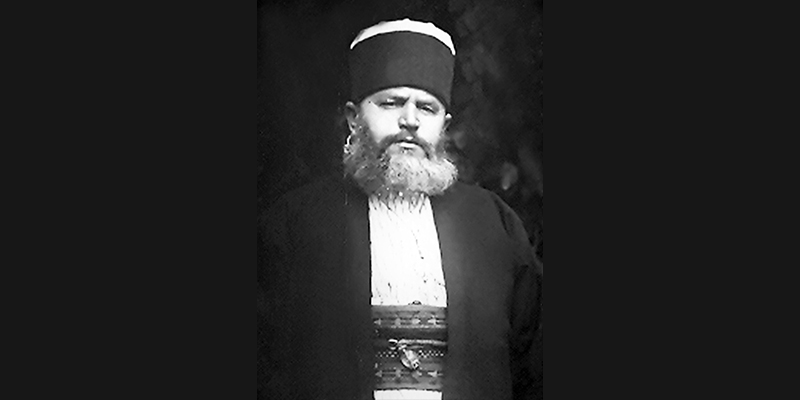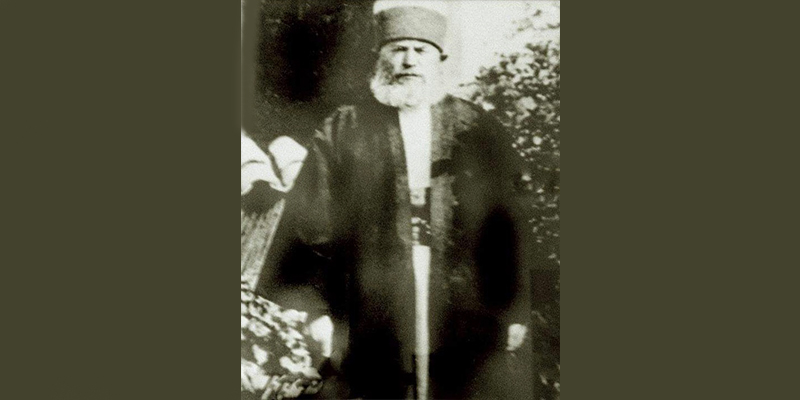
Today marks the 78th anniversary of the death of former Bektashi World Leader Riza Ali Dede. Riza Ali Dede, former Bektashi World Leader, was born in the city of Kruja on October 18, 1876, into a Bektashi family and passed away on February 22, 1944. From an early age, his parents often took him to the tekke. of Dollma, Shememi Baba and other tekkes in his hometown. He was brought up with the wonderful Bektashi faith. Frequent visits to the Sarisalltik tekke on Kruja Mountain, in the Holy Cave, where he went every week with his parents, left special impressions. It was a tradition that all the believers of Kruja did. After the death of his father, Hasan, the burden fell on him to support his family, because Rizai was the eldest of the children. At the age of 14 he worked as a hygienist in Kruja, Shijak, as well as in various jobs. At the age of 18 he went to the tekke of Shememi Baba in Fushë-Krujë and took over the father of the tekke, became a spiritual member, myhib, and over time, gaining knowledge and following the rules and norms of the Bektashi order, was added more love to become a clergyman. With the permission of his family and relatives, he is consecrated a dervish by father Haxhiu (Subashi) of the tekke Shememi Baba. But he wanted to increase his knowledge of Bektashism and constantly sought to continue school abroad with father Haxhiu. For this reason, around 1902, he had the opportunity to go together with the dervish Xhaferri (he also became the Grandfather, in 1944) from Gjirokastra to the Haxhi Bektash World Center in Turkey. Here, for several years, dervish Rizai did school and got the necessary knowledge for the Bektashi way. During this period, he performed Hajj in Mecca, visited the tomb of the Prophet Muhammad, Imam Ali in Najaf and the tombs of the martyrs of Karbala. He also made many visits to Iraq and other Eastern countries. For several years he attended theological school in the Syrian city of Damascus, further enhancing religious theological knowledge and teaching about medicine. In 1914 he returned to Albania, to his hometown, Kruja. But the difficult situation and the dizzying fight of Haxhi Qamil's rebellion, made the dervish Rizai, together with the dervish Asllan Trepshi, go to serve in the tekke of Martanesh for several years, where they left very good traces in the population of this province with traditions in faith and love in God. He communicated with the believers and often went to the Holy place in Ballenjë of Martanesh, to the Cave of Ballëm Sullani with a great history. Here, in the Captain of Martanesh, pilgrimages were made from all over the area and Dibra. In 1918, he was called by father Hamidi of the tekke "Well that washes himself" in Elbasan, (elderly), where he completed his experience under the special care of father Hamid. After the death of Hamid's father, according to Bektashi rules, he occupies his post. Here, until 1941, he worked diligently for 23 years. From year to year his authority increased and he gained a special respect, not only from the Bektashi believers, but from all the inhabitants of Elbasan and the surrounding provinces. With many years of work and religious preaching, he had acquired mystical abilities and talents, which he put in the service of the believers and benefactors of the province of Elbasan, becoming a well-known personality of Bektashism. He prepared many myhibs, dervishes, he also helped dervishes Ahmet Myftar Ahmataj for the culture and religious rites of the Bektashi faith, he saw in him the love, devotion for the family of Ahl al-Bayt, which was a dervishes in his time. He turned the tekke into a beautiful place with a garden, plants and flowers, which was visited by all the citizens of Elbasan. This tekke turned into a hotbed of education and shelter for the poor, radiating kindness, love and brotherhood to all. After the death of the late Supreme Leader, Sali Niazi Dede, on November 28, 1941, in Tirana, the clerical council, on January 10, 1942, elected Father Rizana, the World Supreme Leader of the Bektashis. As Grandfather he first completed the large building started by Sali Niazi Dede and organized work inside and outside the country in strengthening Bektashism. During this period he communicated, cooperated, made connections with many tekkes in the Balkans and beyond. Archival documents clearly speak of this cooperation. During World War II, he contributed to supporting the Homeland liberation movement by activating dervishes and fathers in the Anti-Fascist war. He performed this task until 1944. He died on February 22, 1944 in the hospital of Tirana, but his death is doubtful. In June 1993, his remains were brought from the public cemetery in Tirana and today they are buried in the tombs of dedelers in the Bektashi World Headquarters. He, in 1993, was decorated by the President of the Republic, with the Order of Patriotic Activities of Class I and the Order of Honor of the Nation. Archival documents clearly speak of this cooperation. During World War II, he contributed to supporting the Homeland liberation movement by activating dervishes and fathers in the Anti-Fascist war. He performed this task until 1944. He died on February 22, 1944 in the hospital of Tirana, but his death is doubtful. In June 1993, his remains were brought from the public cemetery in Tirana and today they are buried in the tombs of dedelers in the Bektashi World Headquarters. He, in 1993, was decorated by the President of the Republic, with the Order of Patriotic Activities of Class I and the Order of Honor of the Nation. Archival documents clearly speak of this cooperation. During World War II, he contributed to supporting the Homeland liberation movement by activating dervishes and fathers in the Anti-Fascist war. He performed this task until 1944. He died on February 22, 1944 in the hospital of Tirana, but his death is doubtful. In June 1993, his remains were brought from the public cemetery in Tirana and today they are buried in the tombs of dedelers in the Bektashi World Headquarters. He, in 1993, was decorated by the President of the Republic, with the Order of Patriotic Activities of Class I and the Order of Honor of the Nation. He performed this task until 1944. He died on February 22, 1944 in the hospital of Tirana, but his death is doubtful. In June 1993, his remains were brought from the public cemetery in Tirana and today they are buried in the tombs of dedelers in the Bektashi World Headquarters. He, in 1993, was decorated by the President of the Republic, with the Order of Patriotic Activities of Class I and the Order of Honor of the Nation. He performed this task until 1944. He died on February 22, 1944 in the hospital of Tirana, but his death is doubtful. In June 1993, his remains were brought from the public cemetery in Tirana and today they are buried in the tombs of dedelers in the Bektashi World Headquarters. He, in 1993, was decorated by the President of the Republic, with the Order of Patriotic Activities of Class I and the Order of Honor of the Nation.
Prepared by:
Xhorxhin ÇULLHAI

